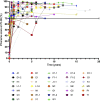Stable long-term outcomes after cochlear implantation in subjects with TMPRSS3 associated hearing loss: a retrospective multicentre study
- PMID: 38102706
- PMCID: PMC10724910
- DOI: 10.1186/s40463-023-00680-3
Stable long-term outcomes after cochlear implantation in subjects with TMPRSS3 associated hearing loss: a retrospective multicentre study
Abstract
Background: The spiral ganglion hypothesis suggests that pathogenic variants in genes preferentially expressed in the spiral ganglion nerves (SGN), may lead to poor cochlear implant (CI) performance. It was long thought that TMPRSS3 was particularly expressed in the SGNs. However, this is not in line with recent reviews evaluating CI performance in subjects with TMPRSS3-associated sensorineural hearing loss (SNHL) reporting overall beneficial outcomes. These outcomes are, however, based on variable follow-up times of, in general, 1 year or less. Therefore, we aimed to 1. evaluate long-term outcomes after CI implantation of speech recognition in quiet in subjects with TMPRSS3-associated SNHL, and 2. test the spiral ganglion hypothesis using the TMPRSS3-group.
Methods: This retrospective, multicentre study evaluated long-term CI performance in a Dutch population with TMPRSS3-associated SNHL. The phoneme scores at 70 dB with CI in the TMPRSS3-group were compared to a control group of fully genotyped cochlear implant users with post-lingual SNHL without genes affecting the SGN, or severe anatomical inner ear malformations. CI-recipients with a phoneme score ≤ 70% at least 1-year post-implantation were considered poor performers and were evaluated in more detail.
Results: The TMPRSS3 group consisted of 29 subjects (N = 33 ears), and the control group of 62 subjects (N = 67 ears). For the TMPRSS3-group, we found an average phoneme score of 89% after 5 years, which remained stable up to 10 years post-implantation. At both 5 and 10-year follow-up, no difference was found in speech recognition in quiet between both groups (p = 0.830 and p = 0.987, respectively). Despite these overall adequate CI outcomes, six CI recipients had a phoneme score of ≤ 70% and were considered poor performers. The latter was observed in subjects with residual hearing post-implantation or older age at implantation.
Conclusion: Subjects with TMPRSS3-associated SNHL have adequate and stable long-term outcomes after cochlear implantation, equal to the performance of genotyped patient with affected genes not expressed in the SGN. These findings are not in line with the spiral ganglion hypothesis. However, more recent studies showed that TMPRSS3 is mainly expressed in the hair cells with only limited SGN expression. Therefore, we cannot confirm nor refute the spiral ganglion hypothesis.
Keywords: Clinical decision-making; Cochlear implant outcomes; Cochlear implantation; Disease management; Hereditary hearing loss; Sensorineural hearing loss; TMPRSS3.
© 2023. The Author(s).
Conflict of interest statement
The authors declare that they have no competing interests.
Figures





References
-
- Smith R, Shearer AE, Camp G. Hereditary hearing loss homepage 2021. https://hereditaryhearingloss.org/. Accessed Feb 2023.
Publication types
MeSH terms
Substances
LinkOut - more resources
Full Text Sources
Medical
Miscellaneous

